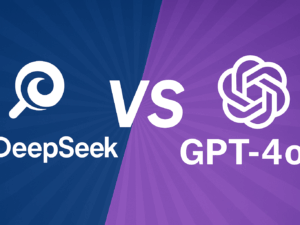The world of artificial intelligence keeps evolving faster than ever—and choosing the right AI tool in 2025 can feel overwhelming.
With countless tools now offering automation, creativity, and smart data solutions, how do you know which one is best for your goals or business?
In this post, I’ll guide you through key steps to help you pick the perfect AI tool in 2025 and beyond, without getting lost in the tech hype.
- Why Choosing the Right AI Tool Matters in 2025
- Define Your Business Goals and Needs
- Look for Scalability and Flexibility
- Check for Compatibility with Existing Systems
- Analyze Accuracy and Performance Speed
- Integration Hell Is Real—Avoid It
- Evaluate Cost and Return on Investment (ROI)
- Look for User Support and Documentation
- Keep an Eye on Security and Privacy Features
- Final Thoughts and Recommendations
Why Choosing the Right AI Tool Matters in 2025
In 2025, AI has moved from being a futuristic buzzword to a daily business essential. From content generation to predictive analytics, AI now powers how we work, sell, and communicate.
Choosing the wrong AI tool can waste time and money—but the right one can help you:
- Automate repetitive tasks
- Generate creative content
- Predict customer behavior
- Improve decision-making
New trends like multimodal AI (which processes text, voice, and images together) and AI agents that act autonomously mean that making a smart choice this year matters more than ever.
Define Your Business Goals and Needs
Before testing any AI platform, ask yourself:
- What do I want to achieve with AI?
- Am I trying to automate workflows, generate content, or analyze data?
AI in 2025 comes in specialized forms—some tools excel at automation, others at creativity or analytics. For example, Sora 2 and Veo 3 focus on video generation, while tools like ChatGPT, Claude, and Perplexity AI are great for research and content.
Involve your team or stakeholders when defining goals. A clear objective keeps your choice practical and ensures your AI solution adds measurable value.
Look for Scalability and Flexibility
Your AI tool should grow as your business grows.
In 2025, many tools now operate in the cloud, offering adaptive performance that scales automatically with your data needs.
Flexibility also matters—choose AI that can connect with future updates or integrate new features such as voice assistants, workflow automations, or custom GPTs.
A scalable, flexible system keeps your investment relevant long-term and saves you from starting over later.
Check for Compatibility with Existing Systems
One of the biggest mistakes businesses make is choosing tools that don’t fit their current setup.
Before subscribing, confirm that your AI tool integrates smoothly with your CRM, email platform, or database. Look for tools that offer API support or plug-and-play extensions for popular systems like Salesforce, Notion, or HubSpot.
A compatible tool prevents workflow interruptions and helps your AI work with your systems, not against them.
Analyze Accuracy and Performance Speed
A tool that spits out 100 blog drafts in 10 minutes is useless if 80% need heavy rewriting.
What I check now:
- Real user reviews on G2 or Reddit (not the homepage testimonials)
- Sample outputs—I make it write my bio
- Uptime stats (yes, some AIs go down more than my WiFi)
Claude nails research. Perplexity saves me 2 hours of Googling. Pick your best.
Modern AI tools often include built-in analytics dashboards so you can track performance, optimize outcomes, and ensure your investment delivers.
Integration Hell Is Real—Avoid It
Nothing kills momentum like copying data between apps at 2 a.m.
Red flags I ignore at my peril:
- “We’ll have Zapier support soon™.”
- No native Slack/Notion/HubSpot plugins
- Requires a dev to set up (unless you have a dev)
I now refuse to touch anything that can’t sync with my CRM in under 5 minutes.
Evaluate Cost and Return on Investment (ROI)
The AI market is more competitive than ever in 2025, which means prices vary widely. Don’t just look at the subscription fee—consider the total cost of ownership:
- Subscription or license fees
- API usage limits
- Maintenance or integration costs
Compare that with your expected returns: time saved, content output, revenue growth, or improved customer satisfaction.
The right tool should pay for itself by boosting productivity or creativity.
Look for User Support and Documentation
AI breaks at weird times. I once had a workflow die mid-campaign because of an API change—no warning. It got resolved within a couple of minutes because Claude support was active to help rectify it immediately.
Green flags:
- Live chat that responds in <5 min
- Discord/Slack community that’s active
- Changelog you can actually read
AI evolves almost monthly, so strong support matters.
The best AI tools also have active developer and user communities that share updates and troubleshooting help.
A responsive support system saves you time and frustration when issues arise.
Keep an Eye on Security and Privacy Features
As AI systems handle more sensitive information, security has become a top priority in 2025.
Ensure your chosen tool uses:
- End-to-end encryption
- Data anonymization
- Role-based access control
Also, confirm compliance with global privacy laws like GDPR and CCPA. Some tools now include audit logs and AI transparency reports—great signs that a company takes your data seriously.
Final Thoughts and Recommendations
Choosing the perfect AI tool in 2025 is about clarity, not complexity.
Start by defining what you want AI to do for you, then focus on scalability, integration, and real-world performance.
Don’t fall for hype—choose tools that are transparent, user-friendly, and align with your business goals.
AI is no longer just a helper—it’s a partner that can elevate your creativity, decision-making, and productivity when chosen wisely.
By following these steps, you’ll not only pick the right tool but also future-proof your strategy for the years ahead.
Advertisements










